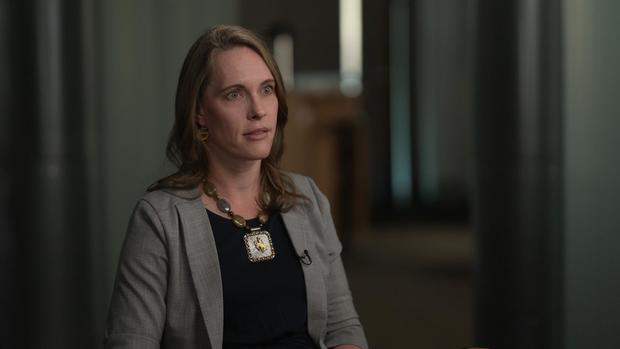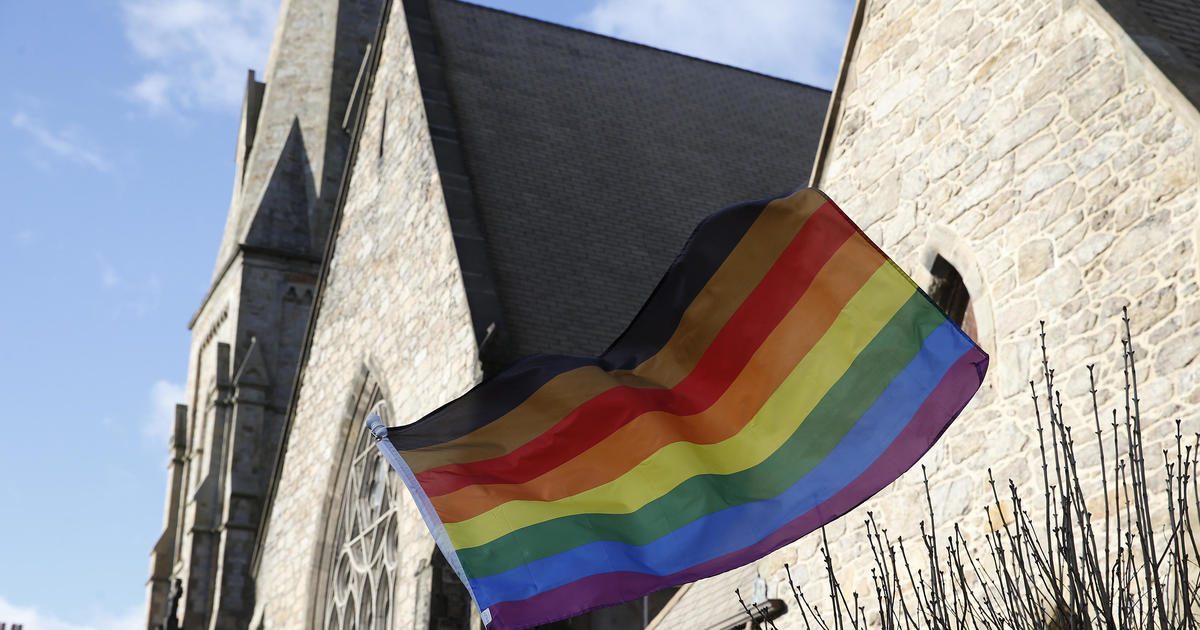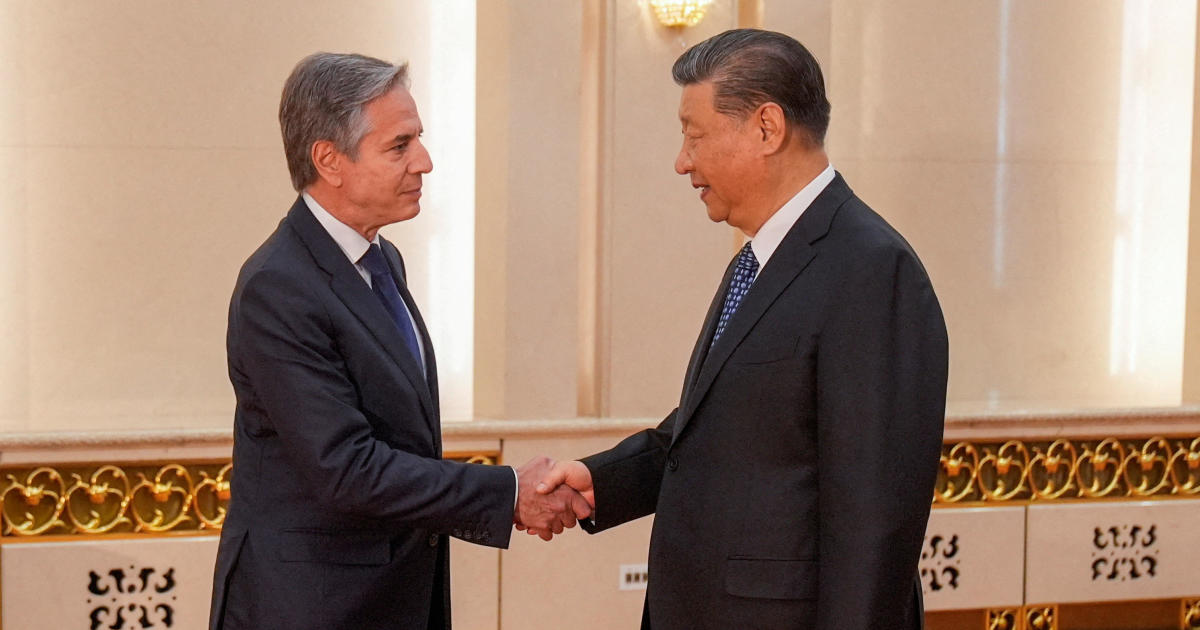Wyoming Gov. Mark Gordon pursues green, carbon-negative agenda in one of the nation's reddest states
Representatives from nearly every nation have met this week at an annual climate summit, searching for agreements on how to curb the rise of global temperatures. The summit is being held in the oil-rich United Arab Emirates, and that has dismayed activists who believe that the only way to really address the climate crisis is to walk away from fossil fuels.
For the moment at least, the world and the United States need both fossil fuels and renewable energy, and the best proof of that may be found in the state of Wyoming.
It is the country's leading coal producing state, and very conservative politically, yet its Republican governor, Mark Gordon, is emerging as a leading voice promoting climate-friendly energy projects and action to address the climate crisis.
Essentially, Mark Gordon is trying to prove that it is possible to be both red and green.
Gov. Mark Gordon: We needed to be aggressive. And we needed to really address this issue.
Bill Whitaker: So you tell the people of Wyoming that climate change is real?
Gov. Mark Gordon: I do.
Bill Whitaker: And that it's urgent, it's an urgent crisis?
Gov. Mark Gordon: I have said that. And I've gotten-- I've gotten some pushback from that as well.
Bill Whitaker: I bet you have. (laughter)
In September, we met Mark Gordon, who's in the middle of his second term as Wyoming's governor, on the cattle ranch where he grew up.
Gov. Mark Gordon: This is my dad's old saddle.
His family still owns this ranch, and he and his wife also operate another about 40 miles away.
Bill Whitaker: How did growing up here affect your worldview?
Gov. Mark Gordon: I think growing up here gave me a-- an enormous appreciation for the world around us, and-- and the ecological processes, and the weather. You just are exposed to it on a regular, on a regular basis.
Mark Gordon is also a mountain climber who has seen glaciers receding due to a warming climate. He says that helped convince him to set a goal of making Wyoming not just carbon neutral when it comes to CO2 emissions, but eventually, carbon negative.
Bill Whitaker: You first made this pledge of-- net negative CO2 emissions at a 2021 State of the State speech. How did that go over?
Gov. Mark Gordon: I think some people probably resented it. I think generally it's been well-respected. It was, to-- to some degree, a bold move, and-- and one that was intended to make a difference in that discussion about energy in the future.
After Gordon repeated his net-negative emissions goal at an appearance at Harvard in October, Wyoming's Republican party passed a vote of "no confidence" in him. But he says heat from the right won't deter him from pursuing what he calls an "all of the above" energy policy.
Gov. Mark Gordon: Whatever you're going to do in energy, probably you're going have something to do in Wyoming. We have tremendous wind resources. We have the largest reserves of uranium, important for nuclear energy, the largest coal producer, we're number eight in oil, number nine in natural gas. 83% of our energy is exported.
That will soon include nuclear power from a next-generation reactor to be built in Wyoming with a $500 million investment from Bill Gates. Huge wind farms already dot Wyoming's landscape, with the biggest one yet on the way.
Bill Miller: Because the wind blows basically 24/7, 365 days a year.
Bill Miller is president of the Power Company of Wyoming, which is beginning to build what will be the largest wind farm in the continental United States, in the middle of a geographic break in the Continental Divide.
Bill Miller: All the winds which blow from west to east pretty much are funneled through this part of the country.
Miller drove to the top of a place called Chokecherry Knob to give us a taste of the wind.
Bill Whitaker: So when this is up and running, how many turbines will be out here?
Bill Miller: Current plan calls for 600 turbines.
Bill Whitaker: And how much energy will that generate?
Bill Miller: They'll generate around 12 million megawatt hours of power a year.
Bill Whitaker: And that's-- and that's enough to power how many homes?
Bill Miller: Million, a million-two.
Wyoming doesn't have anything close to that many homes – it has the smallest population of any of the 50 states – so the plan is to build a new 800 mile-long transmission line to send that power to California, which needs and wants it.
Bill Whitaker: What's this going to cost?
Bill Miller: The wind farm will be something north of $5 billion. Transmission line will be something north of $3 billion capital investment.
Bill Whitaker: That's a big investment.
Bill Miller: Yes.
The project is bankrolled by billionaire Philip Anschutz, who owns the company Bill Miller runs, and who first made his fortune in oil.
Bill Miller: Society has spoken. That's what this country is going to go to, is renewable energy. More importantly, it's a project that contributes to the zero-carbon initiatives that-- we strongly believe in. It's going to happen. And this is the best place for it to happen.
At this past summer's windy groundbreaking ceremony for the transmission line, Bill Miller was joined not just by Republican Gov. Mark Gordon, but also by two members of President Biden's Cabinet.
Gov. Mark Gordon: The way we've tried to navigate this is to find something for everyone. And-- I think that's the–
Bill Whitaker: Is that possible?
Gov. Mark Gordon: Yeah. I think it is. Honestly, I think if-- if people are going to embrace how we get to a carbon neutral, carbon negative future, it has to be by saying, "We're all going to be a little bit better by embracing innovation."
If a single picture can capture Wyoming's energy past, present and future, this may be it: a fully loaded coal train passing in front of a huge wind farm. Remember, this state still produces more coal than any other, by far.
Dr. Holly Krutka: The likelihood that we will truly as a world move away from fossil fuels is very low.
Holly Krutka runs the School of Energy Resources at the University of Wyoming. Before shifting to academia, she worked for Peabody, the largest coal company in America.
Dr. Holly Krutka: 82% of-- our global energy consumption is fossil fuels.
Bill Whitaker: 82%?
Dr. Holly Krutka: 82%. It has not changed.
Because of that stark fact, Krutka and her colleagues are focused on taking the CO2 out of fossil fuels like coal before it reaches the atmosphere, with a technology called carbon capture and storage.
Dr. Holly Krutka: There are carbon capture and storage projects in America working right now. There's just not enough. The capture side, we're there. Today.
Bill Whitaker: You can do it now?
Dr. Holly Krutka: Right now. Yes.
Bill Whitaker: The technology is there, but is it economically feasible?
Dr. Holly Krutka: It will always be cheaper to do nothing than to add carbon capture and storage. If you want to reduce emissions, this is part of the solution. We have to decide, is it worth the cost.
At the huge dry fork coal-fired power plant near Gillette, the University of Wyoming is operating what it calls the Integrated Test Center. Some of the flue gas that would otherwise go up the smokestack is siphoned off into labs like this one, where the Japanese company Kawasaki is testing methods for making carbon capture more economical. Wells, 10 thousand feet deep, have also been drilled to show that captured CO2 can be stored underground, forever.
Bill Whitaker: How big a deal would it be to find-- an affordable way to capture carbon at the point of emission-- say, in power plants-- around the world?
Gov. Mark Gordon: It would be a game changer, for certain.
Bill Whitaker: You know there are a lot of naysayers who say that this is a pipe dream.
Gov. Mark Gordon: Uh-huh (affirm).
Bill Whitaker: It'll never happen. What do you say to them? How do you convince them?
Gov. Mark Gordon: Well, I say we're trying it. And I know people will say, "Well, you're just trying to extend the life of the coal mines." I am. But I am also trying to do that in a way that is going to do more for climate solutions than simply standing up a whole bunch of wind farms or sending up a whole bunch of solars.
With his "all of the above" approach, Mark Gordon is trying to put every kind of energy project on a fast track, including Bill Miller's huge wind farm.
Bill Whitaker: How long did you think it was going to take when you started?
Bill Miller: When I originally started, I thought we could probably get this entitled and under construction within five years.
Bill Whitaker: And it's been 17?
Bill Miller: 17.
Bill Whitaker: Why so long?
Bill Miller: Primarily, the permitting process, the bureaucracy of the federal government.
Bill Whitaker: You told me, coming up here, that the-- the process was kind of like a nightmare.
Bill Miller: It was difficult. (laugh) Maybe, "Nightmare," is a little bit too strong. But-- it was a very difficult process.
Bill Whitaker: So how important is it to reduce regulatory and permitting barriers?
Gov. Mark Gordon: I think it's massive. Permitting reform I think is one of our biggest challenges at a federal level. It is something that's being embraced-- by both sides.
Both the Biden administration and congressional Republicans have endorsed the idea of streamlining permitting for energy projects. Actually doing it is another story. In Wyoming, Gov. Gordon has done what he can.
Cully Cavness: One thing I can share is that it's a state that's very welcoming to innovators in the energy space.
Cully Cavness is co-founder of a company called Crusoe Energy Systems. About five years ago, it decided to tackle the problem of "flaring," when gas produced at oil wells is simply burned into the atmosphere.
Cully Cavness: If you could capture it all it would power about two-thirds of Europe's electricity. It's a very large amount of waste.
Bill Whitaker: And we're just burning it off.
Cully Cavness: We're burning it off because there's no pipeline there.
Cavness and his colleagues came up with the unconventional idea of putting a small electricity-generating power plant right where that gas was being flared and wasted.
Cully Cavness: What we do is we tap into that gas line. We bring the gas over to a power generation system, and then that generates electricity, and we take that electricity directly into our onsite data center to power hundreds or thousands of computers, and then we network the computers to the outside world with fiber or satellite internet to get it offsite.
Bill Whitaker: So you take a-- data center and just basically put it on top of the wellhead.
Cully Cavness: Exactly. It's a modern data center in every way when you're standing inside of it. And then you step out the door and you're in an oil field.
Crusoe Energy first used those electricity-gobbling data centers to mine bitcoin; Now most of that computer power is being used by artificial intelligence companies. The first place to let them try this, in 2018, was Wyoming.
Cully Cavness: That's not necessarily an idea that everyone's going to embrace automatically right off the bat before it's been done before. Wyoming was. They invited us to come do it for the first time here. We did it at a small scale. We proved that it could work. And that helped us attract the funding and the other projects that had helped us scale to where we are today.
Bill Whitaker: How many of these-- centers do you have up and running currently?
Cully Cavness: We're approaching 200. By the end of the year, we'll have about 200 of our modular data centers deployed throughout the United States and now internationally.
Bill Whitaker: So how do you assess your environmental impact?
Cully Cavness So today we're operating at a scale of more than 20 million cubic feet of gas per day that would have otherwise been flared and wasted. We're preventing that flaring. It's on the order of several hundred thousand cars per year being taken off the road in terms of the avoided emissions impact.
Bill Whitaker: Are you trying to send out a message to the rest of the country and even the rest of the world? "If you have a renewable or a climate-friendly idea, bring it here, bring it to Wyoming."
Gov. Mark Gordon: Love to. We, we want to be part of the solution. There are some really remarkable things that if we-- stop talking about what we shouldn't do and start talking about what we can do and how we can embrace that future. And that's what we're dedicated to here in Wyoming.
Produced by Rome Hartman. Associate producer, Sara Kuzmarov. Broadcast associate, Mariah B. Campbell. Edited by Jorge J. García.









